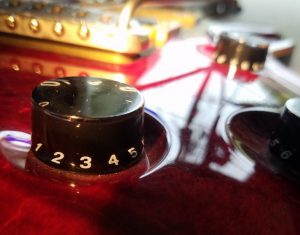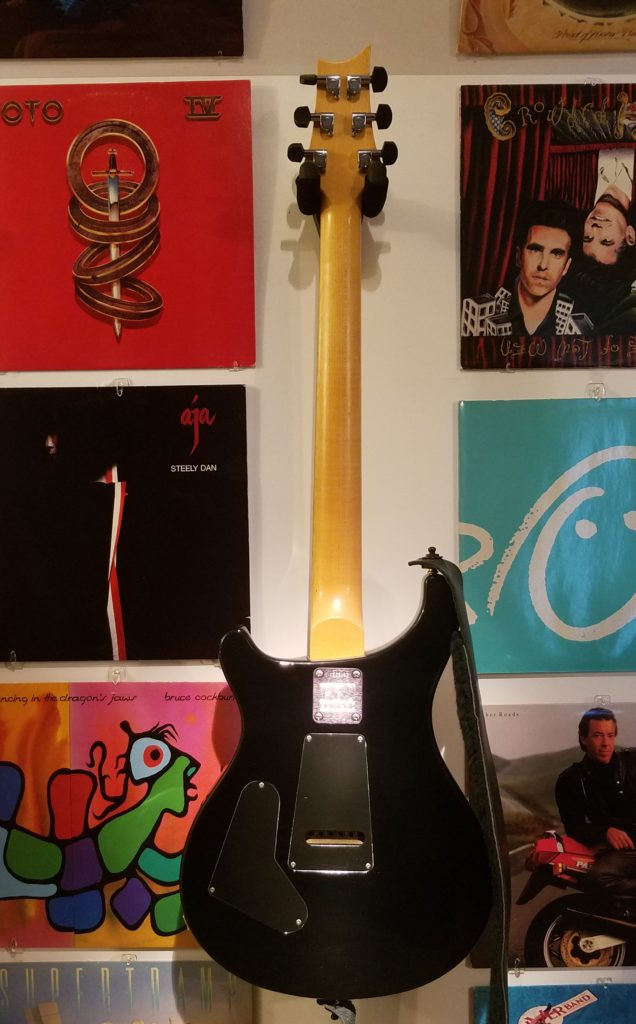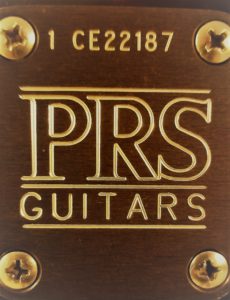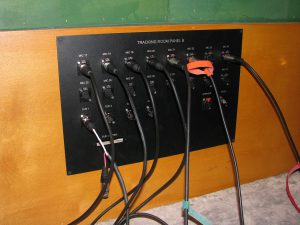
“And it came to pass that the Earth was devoid of inspiration and pleasure, and all was grey and silent drudgery beneath the sun.
So did the gods decide, ‘Let us descend to Earth, and take upon ourselves the mantle of handmade acoustic guitar makers, that we may lighten man’s load, and bid them make merry.’
Thus was sweet musical manna imparted to us, and joy concomitant swaddled ’round our spirits for all mortal times….”
1st Book of Waveforms, chapter 3
You may play acoustic guitar. You may have played many acoustic guitars. But have you ever played…a handmade acoustic guitar?
Or have you ever met or spent time with a gifted luthier who makes these mysterious wonders?? If not, do yourself a metaphysical favor – seek either (or both!) out and discover what the ancient sages knew: nothing beats a handmade instrument!!
In this article we shall trek through fields of harmonic undulations, exacting measurements, wood-bending methodologies (“there is no spoon”) and stairways of angels wrestling lightning to place it in curvy, wooden boxes, where it shall be oft summoned by skillful, stroking fingers forever and ever, amen.
This….is where music meets its makers!
A Heavenly Apparition Becomes Real!

For decades, I had searched for a sign, even a glimpse, of the elusive phantom known as the “custom luthier’. Tho’ occasional signs of his craft would surface, yet no face, no voice, no physical presence could I find. Only his spirit….captured in reverberating sheets of wood.
Then, when I had fallen into darkest agnostic doubt concerning even the existence of this conspiratorial shade, one appeared: wearing stage manager headphones with mic to side of mouth, in the umbral shadowplay of the stage wings before a performance, he uttered the words that still murmur echoes through my vertiginous psyche….”Hi. I’m Mike!”
Little did I know what temptation this, this “Mike” would wield. Scarce was my awareness of the power he possessed! Ne’er could I have prophesied that such a one as I would one day not only encounter this former mental figment, but stare endless minutes, within my studio’s whispering walls, into the hypnotic black hole of one of his children! Ah, the enchantment! The sheer, unveiled magnetism of its form!! Shall ever I escape thee???
Quothe the luthier…..nevermore!!
Food of the Gods…on my plate!!
It wasn’t long after getting to know my now dear luthier friend, Mike Franks, that I was in possession of one of his creations. It all stemmed from his simple (yet dastardly in its grasp!) question: “What would your perfect acoustic guitar be?” That’s it. He had me. And for good reason – because my main musical focus is songwriting and studio production, I was constantly tracking acoustic in the studio, but none of the guitars I’d had up to that point sounded good through the mic; I was always having to adjust and carve frequencies in and out of them to make ’em sound decent.

Then the real head-turner came: I visited his luthier shop. Man! Whoa! Wow! Seeing the spectrum of woods, trims, tops, inlays, pins, pegs, nuts, pickguards, fretboards and beautiful wood body choices surrounding my bedazzled eyes – oh, yes, my friends, my head was spinning, but in a good way!
Of course the coolest part of having a guitar hand-produced for you with specs that you’ve chosen is the sound it makes when you play it. A close second though is being a part of the journey of creation – being able to choose, by touch, all the various individual parts, and then witness them being crafted, chiseled, formed, shaved, fitted, joined, lacquered, polished and finally presented…to YOU!
Nothing like it. If you’re into guitars, trust me…you’re gonna wanna try this.
I told Mike I wanted the perfect recording guitar – one I wouldn’t have to EQ to make it sound good through a mic (especially regarding the low end, on which I inevitably put a high-pass filter for my recordings). No more boominess; no more “where’s the shimmer??”; just a perfectly balanced guitar sound to sing with me under my vocals in my songs.
Well, what can I say except…he came through in spades! Here’s the specs of what I, with Mike’s masterful input, had custom built:
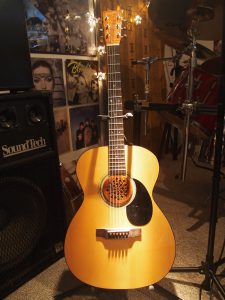
- OM-21 body type
- High-figured KOA wood for sides and back
- Adirondack Spruce wood top, MASTER-grade
- Mahogany neck, blocks and linings
- Brazilian Rosewood fingerboard, bridge & bindings
- Figured KOA headstock w/pearl inlay signature
- Gold Grover tuning machinery
- Fishman Acoustic Matrix pickup
- Walrus bone pins, saddle & nut
- Deluxe hard case to keep this beauty safe in
Just try to find that guitar on the market! You won’t be able to, because it was designed just for me, based on what I need out of an acoustic in the studio.

This masterpiece not only has a sound that draws you in, it has a beauty that catches your eye. And because it’s specifically made for my hands, my songs, my tunings…it always shines on whatever I create with it. Worth it? Oooooh, yes; totally worth it.
Did I pay more than a store-bought, factory-produced instrument? Yup.
Would I do it again??
In a heartbeat. >:-)
The Pantheon is calling you!
There are dozens of custom guitar makers across our humming globe awaiting your beck and call, and their skill sets and experience levels run from incredible to….’I just finished my first guitar yesterday’. There are ways, however, of sifting through the myriad to seperate the divine from the dabbler.
Take, for example, the Woodstock Invitational Luthiers Showcase: every year the most esteemed custom acoustic guitar makers are allowed, by invitation only, to come show their finest works to a huge public gathering in the musically-historic environs of Woodstock, New York. Only the best are chosen, those who bequeath to man the musical manna which drips like honey to the soul. If you choose one of these luthiers, you are on your way to a happy, thriving, music-filled instrument marriage (tho’ if you buy too many all bets are off for your marriage to another human)!

Of course, Mike Franks is one of the select few invited to the Woodstock Showcase, and I’m partial to his works obviously ‘cuz he’s proven his mettle not only to me, but to dozens of other musician friends of mine who now own one (or more!) of his guitars. We all sing his praises, because the guitars speak for themselves. In the end, they are the best reputation he or any of us could ask for.
If this whole “build-it-your-way” story appeals to you, check him out at
Ask him any question you like, or ask the clients of his across the globe that order from him habitually (one guy from France is up to eight Franks guitars now!).
Just know you’re gonna want one. You ARE going to want one.
You have been warned. 😉
No Sky-Cabins From the Gods Here

As always on this site, I want to remind you that I get no kick-back, side-cash, discounts or favors due from my product reviews including this one. I simply share what works (and occasionally what doesn’t) here in my recording studio. This is designed to help you learn from what I now know.
I guess teaching music for decades has brought out this habit in me; I enjoy forging a path that you and others can tread without falling into briar patches of problems and bad investments that I’ve either avoided or learned from the hard way.
Such is my relationship with Mike. I think his products are the bomb and I think you will too.
Whatever the Shape, Heaven Awaits….YOU!
No matter what instrument you play and love, if you haven’t at least played a handmade selection, you are truly missing out on an incredible, inspirational world that you really should experience at least once in your music.
So get out there…try them out! Test and see the difference time, detail, foresight and all-encompassing craftsmanship can bring to bear on an instrument that caters to your specific wishes.
Once luthier shack-ed, you never go back!
Now, go…make…sounds!
Teaj





